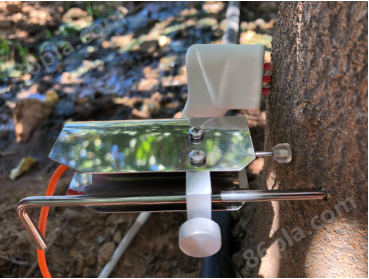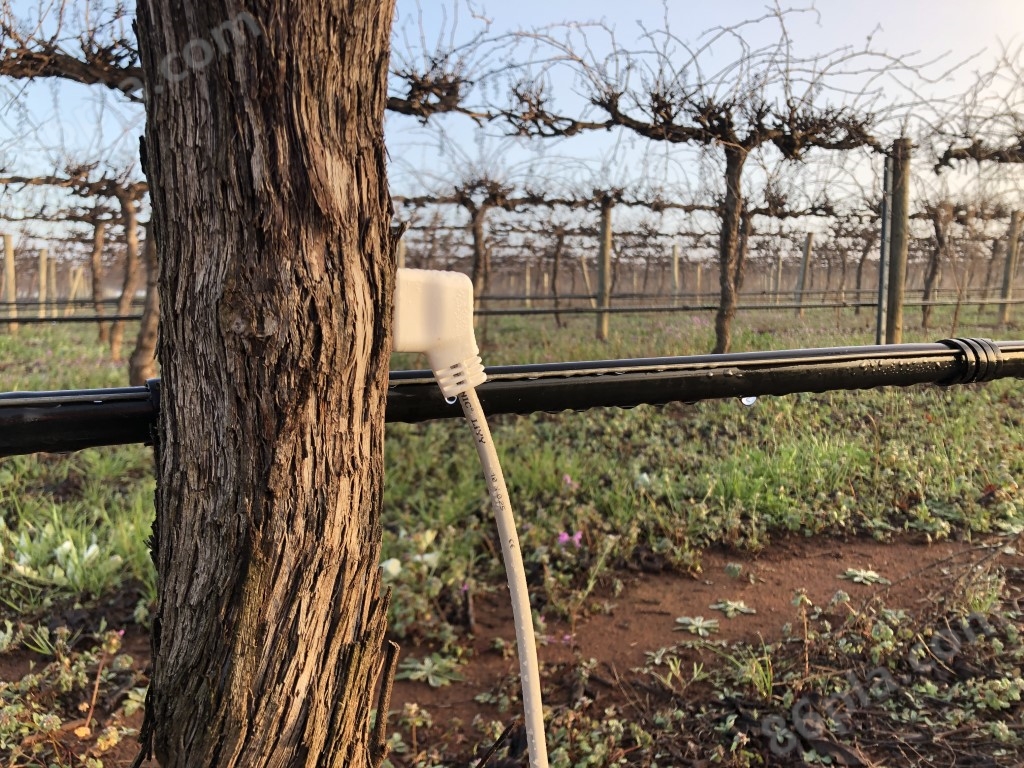注塑機(jī) 擠出機(jī) 造粒機(jī) 吹膜機(jī) 吹塑機(jī) 吹瓶機(jī) 成型機(jī) 吸塑機(jī) 滾塑機(jī) 管材生產(chǎn)線 板材生產(chǎn)線 型材生產(chǎn)線 片材生產(chǎn)線 發(fā)泡設(shè)備 塑料壓延機(jī)
北京博倫經(jīng)緯科技發(fā)展有限公司
會(huì)員1.png)
北京博倫經(jīng)緯科技發(fā)展有限公司
會(huì)員1.png)
| 參 考 價(jià) | 面議 |
產(chǎn)品型號(hào)HPV
品 牌
廠商性質(zhì)其他
所 在 地
塑料機(jī)械網(wǎng)采購(gòu)部電話:0571-88918531 QQ:2568841715
QQ:2568841715
聯(lián)系方式:查看聯(lián)系方式
更新時(shí)間:2024-03-07 15:24:31瀏覽次數(shù):142次
聯(lián)系我時(shí),請(qǐng)告知來(lái)自 塑料機(jī)械網(wǎng)HPV 莖流量傳感器/Sap Flow Sensor
HPV 莖流量傳感器/Sap Flow Sensor

HPV莖流量傳感器是一款校準(zhǔn)型、低成本的熱脈沖液流傳感器,輸出校準(zhǔn)液流量、熱速、莖水含量、莖溫等數(shù)據(jù),功耗低,內(nèi)置加熱控制,同時(shí)改善了傳統(tǒng)的加熱方式,其原理采用雙方法(DMA)熱脈沖法,測(cè)量范圍:-200~+1000cm/hr(熱流速度)或-100~+2000cm3/cm2/hr (莖流通量密度),可廣泛用于于莖流量監(jiān)測(cè)、植物莖流蒸發(fā)計(jì)算、植物莖流蒸騰量、植物灌溉等
植物莖流是樹(shù)木內(nèi)部的“水"運(yùn)動(dòng),而蒸騰是從葉片通過(guò)光合作用蒸發(fā)流出的水分。樹(shù)液流量和蒸騰量之間有很強(qiáng)的關(guān)聯(lián)性,通常理解是同一回事。但是,嚴(yán)格地說(shuō),它們是不同的,這體現(xiàn)在它們是如何被測(cè)量的。
SAP流量以L/hr(或每天、每周等)為單位進(jìn)行測(cè)量。蒸騰量以每小時(shí)、每天、每星期等毫米(mm)為單位測(cè)量。
蒸散量=蒸騰量+蒸發(fā)量
蒸騰量以毫米為測(cè)量單位,可與降雨量以毫米計(jì)作比較。隨著時(shí)間的推移,降雨量(水輸入)應(yīng)與蒸騰量(輸出)相匹配。如果蒸騰作用更高,通常是樹(shù)木作物的蒸騰作用,那么這種差異必須通過(guò)灌溉來(lái)彌補(bǔ)。
蒸發(fā)量(evaporation),蒸發(fā)量是指在一定時(shí)段內(nèi),由土壤或水中的水分經(jīng)蒸發(fā)而散布到空中的量。
1mm(降雨量)=1㎡地面1kg水
1mm(蒸騰量)=1㎡葉面積的1升樹(shù)液流量(水)
例如:在果園和葡萄園等有管理的樹(shù)木作物系統(tǒng)中,蒸發(fā)量與蒸騰量相比非常小。因此,為了簡(jiǎn)化測(cè)量,通常忽略蒸發(fā)量,將蒸騰量取為平均蒸散量(ETo)。
莖流量傳感器廣泛應(yīng)用
計(jì)算總流量
低液流和零液流速率
反向液流速率
夜間水分損失
根莖液流速度
貧瘠生態(tài)系統(tǒng)及干旱
徑向液體流速
葡萄藤的液流
莖流量傳感器  技術(shù)指標(biāo)
技術(shù)指標(biāo)
測(cè)量范圍:-200~+1000cm/hr(熱流速度)
分辨率:0.001cm/hr
準(zhǔn)確度:±0.1cm/hr
探針尺寸:φ1.3mm*L30mm
溫度位置:外10mm,內(nèi)20mm
針距:6mm
探針材質(zhì):316不銹鋼
溫度范圍:-30~+70℃
響應(yīng)時(shí)間:200ms
加熱電阻:39Ω,400J/m
電源:12V DC
電流:空閑5mA, 測(cè)量<270mA
線纜:5m,*大60m
莖流量傳感器參考文獻(xiàn):
1. Kim, H.K.; Park, J.; Hwang, I. Investigating water transport through the xylem network in vascular plants.
J. Exp. Bot. 2014, 65, 1895–1904. [CrossRef] [PubMed]
2. Steppe, K.; Vandegehuchte, M.W.; Tognetti, R.; Mencuccini, M. Sap flow as a key trait in the understanding of plant hydraulic functioning. Tree Physiol. 2015, 35, 341–345. [CrossRef] [PubMed]
3. Vandegehuchte, M.W.; Steppe, K. Sap-flux density measurement methods: Working principles and
applicability. Funct. Plant Biol. 2013, 40, 213–223. [CrossRef]
4. Marshall, D.C. Measurement of sap flow in conifers by heat transport. Plant Physiol. 1958 , 33, 385–396.
[CrossRef] [PubMed]
5. Cohen, Y.; Fuchs, M.; Green, G.C. Improvement of the heat pulse method for determining sap flow in trees. Plant Cell Environ. 1981, 4, 391–397. [CrossRef]
6. Green, S.R.; Clothier, B.; Jardine, B. Theory and practical application of heat pulse to measure sap flow.
Agron. J. 2003, 95, 1371–1379. [CrossRef]
7. Burgess, S.S.O.; Adams, M.A.; Turner, N.C.; Beverly, C.R.; Ong, C.K.; Khan, A.A.H.; Bleby, T.M. An improved heat-pulse method to measure low and reverse rates of sap flow in woody plants. Tree Physiol. 2001 , 21, 589–598. [CrossRef]
8. Forster, M.A. How reliable are heat pulse velocity methods for estimating tree transpiration? Forests 2017 , 8, 350. [CrossRef]
9. Bleby, T.M.; McElrone, A.J.; Burgess, S.S.O. Limitations of the HRM: Great at low flow rates, but no yet up to speed? In Proceedings of the 7th International Workshop on Sap Flow: Book of Abstracts, Seville, Spain, 22–24 October 2008.
10. Pearsall, K.R.; Williams, L.E.; Castorani, S.; Bleby, T.M.; McElrone, A.J. Evaluating the potential of a novel dual heat-pulse sensor to measure volumetric water use in grapevines under a range of flow conditions. Funct. Plant Biol. 2014, 41, 874–883. [CrossRef]
11. Clearwater, M.J.; Luo, Z.; Mazzeo, M.; Dichio, B. An external heat pulse method for measurement of sap flow through fruit pedicels, leaf petioles and other small-diameter stems. Plant Cell Environ. 2009 , 32, 1652–1663.[CrossRef]
12. Green, S.R.; Romero, R. Can we improve heat-pulse to measure low and reverse flows? Acta Hortic. 2012 , 951, 19–29. [CrossRef]
13. Green, S.; Clothier, B.; Perie, E. A re-analysis of heat pulse theory across a wide range of sap flows. Acta Hortic. 2009, 846, 95–104. [CrossRef]
14. Ferreira, M.I.; Green, S.; Concei??o, N.; Fernández, J. Assessing hydraulic redistribution with the
compensated average gradient heat-pulse method on rain-fed olive trees. Plant Soil 2018 , 425, 21–41.
[CrossRef]
15. Romero, R.; Muriel, J.L.; Garcia, I.; Green, S.R.; Clothier, B.E. Improving heat-pulse methods to extend the measurement range including reverse flows. Acta Hortic. 2012, 951, 31–38. [CrossRef]
16. Testi, L.; Villalobos, F. New approach for measuring low sap velocities in trees. Agric. Meteorol. 2009 , 149, 730–734. [CrossRef]
17. Vandegehuchte, M.W.; Steppe, K. Sapflow+: A four-needle heat-pulse sap flow sensor enabling nonempirical sap flux density and water content measurements. New Phytol. 2012, 196, 306–317. [CrossRef] [PubMed]
18. Kluitenberg, G.J.; Ham, J.M. Improved theory for calculating sap flow with the heat pulse method.
Agric. For. Meteorol. 2004, 126, 169–173. [CrossRef]
19. Vandegehuchte, M.W.; Steppe, K. Improving sap-flux density measurements by correctly determining
thermal diffusivity, differentiating between bound and unbound water. Tree Physiol. 2012 , 32, 930–942.
[CrossRef]
20. Looker, N.; Martin, J.; Jencso, K.; Hu, J. Contribution of sapwood traits to uncertainty in conifer sap flow as estimated with the heat-ratio method. Agric. For. Meteorol. 2016, 223, 60–71. [CrossRef]
21. Edwards, W.R.N.; Warwick, N.W.M. Transpiration from a kiwifruit vine as estimated by the heat pulse
technique and the Penman-Monteith equation. N. Z. J. Agric. Res. 1984, 27, 537–543. [CrossRef]
22. Becker, P.; Edwards, W.R.N. Corrected heat capacity of wood for sap flow calculations. Tree Physiol 1999 , 19, 767–768. [CrossRef]
23. Hogg, E.H.; Black, T.A.; den Hartog, G.; Neumann, H.H.; Zimmermann, R.; Hurdle, P.A.; Blanken, P.D.;
Nesic, Z.; Yang, P.C.; Staebler, R.M.; et al. A comparison of sap flow and eddy fluxes of water vapor from a
boreal deciduous forest. J. Geophys. Res. 1997, 102, 28929–28937. [CrossRef]
24. Barkas, W.W. Fibre saturation point of wood. Nature 1935, 135, 545. [CrossRef]
25. Kollmann, F.F.P.; Cote, W.A., Jr. Principles of Wood Science and Technology: Solid Wood; Springer: Berlin Heidelberg, Germany, 1968.
26. Swanson, R.H.; Whitfield, D.W.A. A numerical analysis of heat pulse velocity and theory. J. Exp. Bot. 1981 ,32, 221–239. [CrossRef]
27. Barrett, D.J.; Hatton, T.J.; Ash, J.E.; Ball, M.C. Evaluation of the heat pulse velocity technique for measurement of sap flow in rainforest and eucalypt forest species of south-eastern Australia. Plant Cell Environ. 1995 , 18, 463–469. [CrossRef]
28. Biosecurity Queensland. Environmental Weeds of Australia for Biosecurity Queensland Edition; Queensland Government: Brisbane, Australia, 2016.
29. Steppe, K.; de Pauw, D.J.W.; Doody, T.M.; Teskey, R.O. A comparison of sap flux density using thermal
dissipation, heat pulse velocity and heat field deformation methods. Agric. For. Meteorol. 2010 , 150, 1046–1056. [CrossRef]
30. López-Bernal, A.; Testi, L.; Villalobos, F.J. A single-probe heat pulse method for estimating sap velocity in trees. New Phytol. 2017, 216, 321–329. [CrossRef] [PubMed]
31. Forster, M.A. How significant is nocturnal sap flow? Tree Physiol. 2014, 34, 757–765. [CrossRef] [PubMed]
32. Cohen, Y.; Fuchs, M.; Falkenflug, V.; Moreshet, S. Calibrated heat pulse method for determining water uptake in cotton. Agron. J. 1988, 80, 398–402. [CrossRef]
33. Cohen, Y.; Takeuchi, S.; Nozaka, J.; Yano, T. Accuracy of sap flow measurement using heat balance and heat pulse methods. Agron. J. 1993, 85, 1080–1086. [CrossRef]
34. Lassoie, J.P.; Scott, D.R.M.; Fritschen, L.J. Transpiration studies in Douglas-fir using the heat pulse technique. For. Sci. 1977, 23, 377–390.
35. Wang, S.; Fan, J.; Wang, Q. Determining evapotranspiration of a Chinese Willow stand with three-needleheat-pulse probes. Soil Sci. Soc. Am. J. 2015, 79, 1545–1555. [CrossRef]
36. Bleby, T.M.; Burgess, S.S.O.; Adams, M.A. A validation, comparison and error analysis of two heat-pulse methods for measuring sap flow in Eucalyptus marginata saplings. Funct. Plant Biol. 2004 , 31, 645–658.[CrossRef]
37. Madurapperuma, W.S.; Bleby, T.M.; Burgess, S.S.O. Evaluation of sap flow methods to determine water use by cted palms. Environ. Exp. Bot. 2009, 66, 372–380. [CrossRef]
38. Green, S.R. Measurement and modelling the transpiration of fruit trees and grapevines for irrigation
scheduling. Acta Hortic. 2008, 792, 321–332. [CrossRef]
39. Intrigliolo, D.S.; Lakso, A.N.; Piccioni, R.M. Grapevine cv. ‘Riesling’ water use in the northeastern United
States. Irrig. Sci. 2009, 27, 253–262. [CrossRef]
40. Eliades, M.; Bruggeman, A.; Djuma, H.; Lubczynski, M. Tree water dynamics in a semi-arid, Pinus brutia
forest. Water 2018, 10, 1039. [CrossRef]
41. Zhao, C.Y.; Si, J.H.; Qi, F.; Yu, T.F.; Li, P.D. Comparative study of daytime and nighttime sap flow of Populus euphratica. Plant Growth Regul. 2017, 82, 353–362. [CrossRef]
42. Deng, Z.; Guan, H.; Hutson, J.; Forster, M.A.; Wang, Y.; Simmons, C.T. A vegetation focused soil-plant-atmospheric continuum model to study hydrodynamic soil-plant water relations. Water Resour. Res. 2017, 53, 4965–4983. [CrossRef]
43. Doronila, A.I.; Forster, M.A. Performance measurement via sap flow monitoring of three Eucalyptus species for mine site and dryland salinity phytoremediation. Int. J. Phytoremed. 2015, 17, 101–108. [CrossRef]
44. López-Bernal, á.; Alcántara, E.; Villalobos, F.J. Thermal properties of sapwood fruit trees as affected by
anatomy and water potential: Errors in sap flux density measurements based on heat pulse methods. Trees
2014, 28, 1623–1634. [CrossRef]
您感興趣的產(chǎn)品PRODUCTS YOU ARE INTERESTED IN
塑料機(jī)械網(wǎng) 設(shè)計(jì)制作,未經(jīng)允許翻錄必究 .? ? ?
請(qǐng)輸入賬號(hào)
請(qǐng)輸入密碼
請(qǐng)輸驗(yàn)證碼
請(qǐng)輸入你感興趣的產(chǎn)品
請(qǐng)簡(jiǎn)單描述您的需求
請(qǐng)選擇省份
聯(lián)系方式
北京博倫經(jīng)緯科技發(fā)展有限公司
